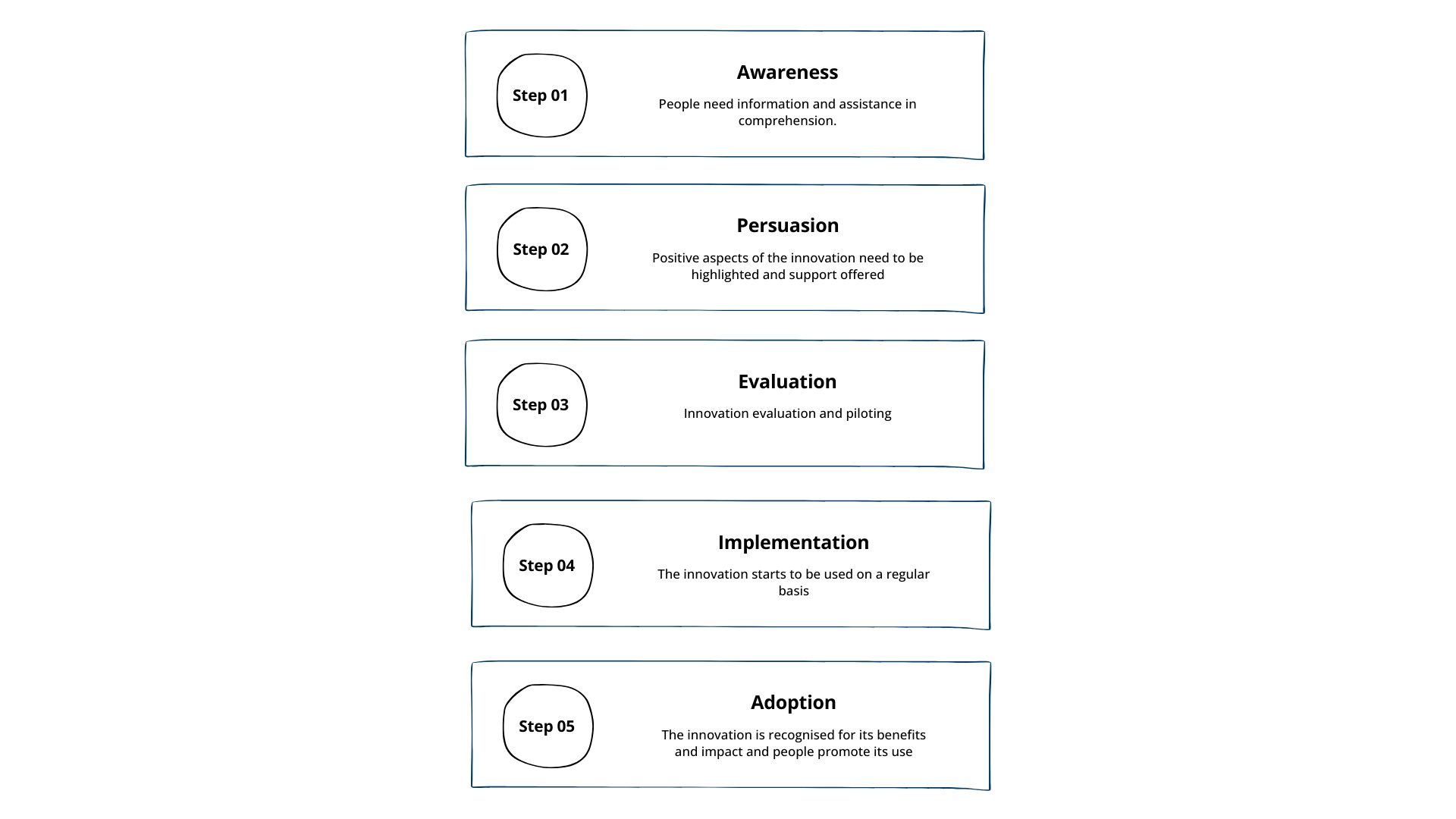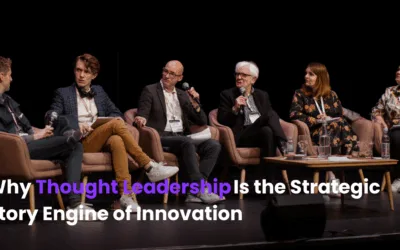How do new ideas or technologies spread through societies? The diffusion of innovation theory, developed by E.M. Rogers, explains this process from initial introduction to broad adoption. It’s an essential theory that helps entrepreneurs, marketers and innovators map the key stages of technology adoption, understand how to reach the correct type of adopters, and factors influencing the speed of diffusion.
Key Takeaways
- The Diffusion of Innovations Theory outlines five main elements—innovation, adopters, communication channels, time, and the social system—that influence how and at what rate new ideas spread.
- Innovators, early adopters, early majority, late majority, and laggards represent distinct adopter categories, each playing a critical role in the diffusion process.
- Factors such as relative advantage, compatibility, complexity, trialability, and observability significantly impact the speed of innovation adoption, while cultural stigma and perceived risks often serve as barriers.
Understanding Diffusion of Innovation Theory
The diffusion of innovations theory explains how advancements spread across societies, detailing stages from introduction to widespread adoption. Developed by E.M. Rogers in 1962, this theory provides a comprehensive framework for understanding how, why, and at what rate new ideas and technology spread. Anyone interested in the way that new ideas are adopted will find this theory invaluable for understanding how new ideas gain traction and become part of everyday life (and work).
The theory’s core components include the rate of adoption, the categories of adopters, and the various stages through which innovations pass. The Internet, for instance, has revolutionized the diffusion process by diminishing the importance of physical distance, making it easier for new technologies to reach a global audience.
Understanding these components means that it is possible to form a predictable pattern of innovation adoption across a population.
Key Concepts of Diffusion Theory
At the heart of the diffusion of innovations theory are five main elements:
- Innovation
- Adopters
- Communication channels
- Time
- The social system
As explained above, all these components interact to influence how and at what speed new ideas spread through a population. However, the secret sauce is communication. Communication effectiveness, especially among individuals with similar characteristics (what are known as “homophilous individuals“), significantly influences the diffusion process. In marketing we know that “lookalike audiences” represent a powerful growth opportunity.
A population or an audience’s knowledge about an innovation is often acquired through mass media, but changing attitudes towards that innovation typically involves social influences. Most people overcome uncertainty about new innovations by seeking out others who have adopted the new idea.
In fields like public health, early adopters help create awareness and promote new health practices among broader populations.
The S-Curve of Adoption
One of the most compelling visual representations of innovation diffusion is the S-curve. This curve illustrates how new ideas and technologies are adopted over time. Initially, adoption starts slowly as only a few individuals take the risk to try the new innovation. As these earlier adopters begin to see the benefits, the adoption rate accelerates during the rapid growth phase.
Eventually, the innovation reaches a critical mass, where adoption peaks before gradually declining and plateauing as the market saturates. This pattern, consistent across various innovations from technological advancements to new health practices, demonstrates the predictability and reliability of the diffusion process.
Categories of Adopters in Innovation Theory
Innovation theory categorizes adopters into five distinct groups:
- Innovators
- Early adopters
- Early majority
- Late majority
- Laggards
Each of these groups plays a unique role in the diffusion process, influencing how quickly and effectively an innovation spreads through a population.
Innovators and early adopters are the first to embrace new technologies, often acting as catalysts for broader acceptance. The early majority and late majority wait for more evidence of success before adopting, while laggards are the last to join, usually out of necessity rather than choice.
These categories help organisations target their efforts more effectively.
Innovators and Early Adopters
Innovators are the trailblazers, the first to acquire new products and technologies. They are characterised as risk-takers who are not sensitive to price and are willing to experiment with new ideas. Innovators pave the way for acceptance by demonstrating the potential of new innovations.
Early adopters are more cautious than innovators. They wait for reviews and feedback before committing but play a critical role as opinion leaders and role models within their social systems. Their endorsement can significantly influence the early majority to follow suit.
Early Majority and Late Majority
The early majority makes more deliberate decisions. They prefer to wait until an innovation has been tested and proven by others, relying heavily on social validation. This group represents a significant portion of the population and plays a crucial role in achieving widespread adoption.
The late majority is generally more sceptical and resistant to change. They adopt innovations only after the majority of society has accepted them, often due to social pressure or the necessity to stay current.
The early and late majority are essential for overall stability and acceptance of new innovations within society.
Laggards
Laggards are the final group to adopt innovations, often characterised by their resistance to change and preference for traditional methods. They represent about 16% of the population and are generally risk-averse. Laggards typically adopt new technology only when they are virtually forced to, either by social pressure or because the traditional options are no longer viable.
Understanding laggards’ characteristics helps organisations develop strategies to address their concerns and encourage adoption, even if it takes longer.
Factors Influencing Innovation Diffusion
Several factors influence the speed and success of innovation diffusion. Communication methods and subjective perceptions of the innovation play significant roles. Organisational characteristics, such as the tension for change and innovation-system fit, also impact adoption rates.
Barriers to innovation, including cost factors, knowledge challenges, and market obstacles, can significantly hinder the diffusion process. Cultural norms and societal contexts further influence how quickly an innovation spreads. These factors are crucial for developing effective strategies to promote new technologies and ideas.
Relative Advantage and Compatibility
Relative advantage refers to the perceived benefits an innovation holds over existing alternatives. Innovations with clear and substantial advantages are more likely to be adopted quickly. Laggards often resist due to their strong preference for traditional methods and systems.
Compatibility, or how well an innovation fits with existing values and practices, is another critical factor. Ongoing evaluation of user experiences can help maintain or improve adoption rates by ensuring the innovation remains relevant and beneficial.
Complexity and Trialability
Easily understood and used innovations tend to spread more rapidly. Perceived complexity can hinder adoption, as potential adopters may find it challenging to integrate complicated innovations into their routines.
Trialability, or the ability to test an innovation on a small scale, reduces perceived risk and encourages adoption. Innovations allowing trial runs often see higher adoption rates as they provide users with the confidence to commit fully.
Observability
Observing the benefits of an innovation plays a crucial role in its adoption. Potential adopters are more likely to consider innovations they see being used successfully by others.
Regular evaluation of user satisfaction and engagement provides valuable insights into the innovation’s effectiveness, supporting continuous improvement efforts. Visibility and positive outcomes enhance the likelihood of widespread adoption.
The Innovation Decision Process

The innovation decision process outlines the steps individuals or organisations go through when deciding whether to adopt an innovation process. These stages significantly aid in successfully adopting innovations.
The five steps in this process are awareness, persuasion, evaluation, implementation, and adoption, which Rogers later renamed to knowledge, persuasion, decision, implementation, and confirmation. Following these stages helps organizations and individuals make informed decisions about adopting new technologies.
Awareness and Persuasion
The initial phase involves awareness and understanding the innovation’s workings. People form opinions based on exposure to the innovation and consult others who have already adopted it to alleviate uncertainty.
The persuasion stage is when individuals develop either a positive or negative attitude towards the innovation, influenced by the visible benefits and outcomes. Effective communication and showcasing immediate benefits enhance consumer interest and adoption rates.
Evaluation and Implementation
During the evaluation phase, individuals actively engage in activities leading to a choice about adoption. Once the decision is made, they implement the innovation, integrating it into their practices.
Implementation refers to the actual use of the innovation after deciding to adopt it. This phase includes putting the innovation into practice and making necessary adjustments to ensure its effectiveness.
Adoption
In the adoption stage, adopters look for experiences and information that reinforce their adoption decision. They assess the positive impacts of the innovation in their routines and seek validation for their choice. Adopters may reconsider their decision if they encounter conflicting messages or unsatisfactory outcomes during this phase.
Feedback loops help organizations understand user experiences, adapt strategies, and enhance product features based on user input.
Barriers to Innovation Adoption
Barriers to innovation adoption often hinder the spreading and uptake of new ideas and technologies. These obstacles can include perceptions surrounding the usage or value of the innovation, associated risks, psychological factors, and cultural stigma. Understanding these barriers is key to developing strategies to overcome them and promote new technologies.
Perceived risks and cultural stigma significantly slow or prevent adoption.
Perceived Risks and Costs
Costs associated with an innovation include monetary, non-monetary, direct, and indirect. Direct costs typically involve financial liquidity and the economic state, which can make firms hesitate to adopt new innovations due to fears of inadequate returns on investment.
Indirect costs, such as social conflict from new technologies, can also discourage adoption alongside direct financial expenditures. Perceived risks and costs, whether financial, social, or psychological, critically slow down the adoption of innovations.
Cultural Stigma
Cultural limitations and societal norms can significantly hinder the adoption of new innovations. Societal norms can stigmatise new technologies, affecting their acceptance. This aversion is particularly strong among individuals with low social status within the adopter categories.
Cultural stigma and societal norms can significantly impede the diffusion of innovation. Addressing these cultural barriers is essential for successfully adopting new technologies, especially in diverse social systems.
Applications of Diffusion of Innovation Theory
The diffusion of innovation theory has broad applications across various fields, including marketing, public health, and technological innovation. Its principles help explain how new ideas spread and are adopted by different segments of the population, providing valuable insights for strategizing and implementing new initiatives.
One contemporary example is the rise of TikTok, which launched globally in 2018 and quickly attracted over 1 billion active users. This rapid adoption showcases how understanding the diffusion process can lead to successful outcomes in today’s digital age.
Marketing Strategies
In marketing, understanding the rate at which consumers may adopt new products is crucial for developing effective strategies. Marketers often identify enthusiastic individuals as early adopters to generate buzz, leveraging their influence to reach a broader audience.
Mass media and effective communication channels are essential for spreading awareness and persuading potential adopters. Role models and opinion leaders significantly influence the early and late majority, driving the adoption process forward.
Public Health Interventions
Public health programs use diffusion of innovation theory to promote beneficial health practices among communities. Cultural beliefs and societal norms can pose significant challenges, affecting the overall success of these initiatives.
Addressing cultural barriers is essential for adopting new health practices, such as family planning and boiling water for sanitation. Understanding these barriers and developing targeted strategies can enhance the effectiveness of public health interventions.
Technological Innovations
Diffusion theory is vital in understanding how technological innovations, like personal computers and social media platforms, are adopted by different population segments. Innovations with a clear relative advantage and compatibility with existing systems are more likely to experience faster adoption rates.
Overcoming perceived risks and cultural stigma is crucial for successfully diffusing new technologies. Targeted strategies to address these challenges can enhance adoption and ensure widespread acceptance of technological advancements.
Measuring Success in Innovation Diffusion
Measuring success in innovation diffusion is essential for evaluating strategies and making informed decisions. Adoption metrics are key indicators that help organizations track the rate and extent of innovation adoption. Applying these measurements can significantly enhance future innovation strategies.
Feedback and continuous improvement processes are critical for ensuring sustained adoption of innovations over time.
Adoption Metrics
Evaluating the success of innovation diffusion involves analyzing user engagement and adoption rates. Key metrics include growth rate, time to adoption, and market penetration, which provide insights into how quickly and extensively an innovation is adopted.
Metrics such as the rate of adoption, total number of adopters, and the speed of new user engagement are essential for understanding its impact. Conversion rates, indicating the percentage of visitors who take a desired action, also play a crucial role in evaluating success.
Feedback and Continuous Improvement
Feedback loops are crucial for recognizing areas of improvement in the adoption process. Regular evaluation of user satisfaction and engagement supports continuous improvement efforts, leading to higher sustained adoption rates.
Effective communication and adapting strategies based on user feedback are essential for maintaining an innovation’s relevance and effectiveness. This ongoing process ensures innovations remain beneficial and widely adopted over time.
Applying the Diffusion of Innovation theory
Understanding the diffusion of innovation theory provides valuable insights into how new ideas and technologies spread across societies. From the key concepts and categories of adopters to the factors influencing adoption and the barriers that can hinder it, this theory offers a comprehensive framework for analyzing and promoting innovation.
By applying the principles of diffusion of innovation theory, organizations can develop effective strategies to encourage the adoption of new technologies, improve public health interventions, and enhance marketing efforts. Embracing this understanding can drive progress and ensure that beneficial innovations reach their full potential.
Frequently Asked Questions
What is an example of diffusion of innovation?
An example of diffusion of innovation is the rapid adoption of TikTok, which launched globally in 2018 and gained popularity through early adopters before reaching mass acceptance. Similarly, the widespread use of computers among educated professionals starting in the 1990s illustrates this theory as they demonstrated the technology’s benefits to others.
What are the 5 stages of diffusion of innovation theory?
The five stages of the diffusion of innovation theory, as proposed by Everett Rogers, are awareness, persuasion, evaluation, implementation, and adoption. These stages reflect the decision-making process individuals go through when considering new innovations.
What is meant by diffusion of innovation?
The diffusion of innovation refers to the process through which new ideas, technologies, or products gradually spread within a population over time. This phenomenon highlights the varied rates at which individuals adopt innovations based on their social systems.
What is the diffusion of innovation theory?
The diffusion of innovation theory describes the process by which new ideas and technologies are adopted within a society, detailing stages from initial introduction to overall acceptance. This framework is essential for understanding how innovations impact social change.
Who developed the diffusion of innovations theory?
The diffusion of innovations theory was developed by E.M. Rogers in 1962.




